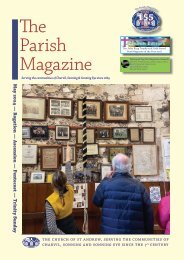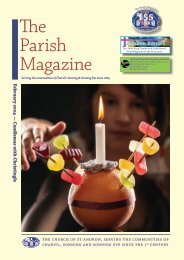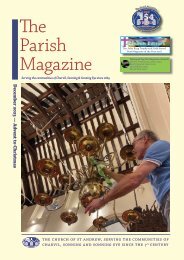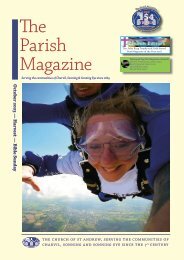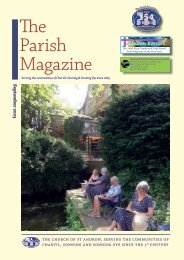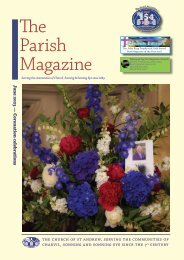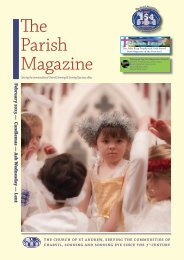The Parish Magazine January 2021
Create successful ePaper yourself
Turn your PDF publications into a flip-book with our unique Google optimized e-Paper software.
feature — 3
Pandemics: An historical perspective
The Parish Magazine - January 2021 19
By Dr Tim Mason
turn to page 21
Marseille was the last-significant European outbreak of the 'Black Death' pandemic
Heritage/Dreamstime.com
We are currently threatened by
the Coronavirus which has caused
a global epidemic, a pandemic, of
Covid-19. Pandemics though are
nothing new and over the centuries
we have developed ways of dealing
with them. This is a brief history of
pandemics and ways of responding
to them. Today’s problems are not so
dissimilar to those of the past.
One of the first pandemics of which
we are aware was ‘The Plague’.
Starting out as a harmless bacterium
colonising reptile intestines it had,
by 1000BCE, evolved to cause lethal
infections in people.
That evolution continued for
another millennium when, in 180CE,
a strain arose which would change
the course of human history.
By 660CE it had killed a third of
the population of Constantinople,
from where it spread further west,
reaching Britain 120 years later.
That’s less than 20 miles per year!
History shows us then, that
pandemics begin imperceptibly as
microbes evolve and are then spread
by human activity.
CHINA ORIGIN
A second pandemic of the Plague,
one which became known as ‘The
Black Death’, originated in China
around 1200.
From there, facilitated by trade
and warfare, it spread at twice the
speed of the first. It arrived in Dorset
on 7 July 1348, an event now proudly
recorded there, on a plaque!
From here it spread along the
coast in small trading vessels,
arriving in my home village of
Titchfield in October that year - the
first place in Hampshire to get the
disease.
The Manorial Court there
recorded eight deaths that month, a
figure which by May of the following
year had increased to a total of 155, a
third of the population. A death toll
that was repeated throughout the
land.
INFECTIOUS
By this time the disease was
recognised as infectious, so the
response made to it was to prevent
the sick from coming into contact
with the healthy.
Houses where a sick person lived
were sealed up, leaving sick and
healthy together to their fate. Doors
were guarded and food provided.
No-one was allowed in or out for six
weeks.
By that time sufferers would have
either died or recovered and certainly
none would be infectious. We’d call
that enforced quarantine today.
Windsor in the 16th Century
adopted an even more radical
measure. Seeing London as a
potential source of infection, they set
up a gallows to hang anyone arriving
from there! A rather extreme
enforcement of Lockdown!
A century later the capital was
again suffering from the disease and,
in an attempt to escape it, Charles I
moved the law courts out to Reading.
The result was an outbreak of the
disease there and sufferers were
moved out to a recently built ‘Pest
House’ in Whitley.
The disease remained a threat
until the late 18th Century, by
which time improved housing and
nutrition, along with recognition
that rats were an undesirable
presence in places of human
habitation, saw the disease decline.
This decline was probably
also driven by a drop in global
temperature. It was not unusual for
the Thames to freeze over for up to
two months!
VACCINES
While pandemics of plague ceased
without vaccines, the expectation
is that a vaccine will soon be widely
available for Covid-19.
The first disease for which a
vaccine was produced was smallpox,
which had been causing pandemics
since the second century CE.
That disease was caused by the
variola virus. It had been recognised
well before that, in China in the 5th
Century BCE. They observed that it
could only be contracted once and, by
the 10th Century CE, it was common
turn to page 21




